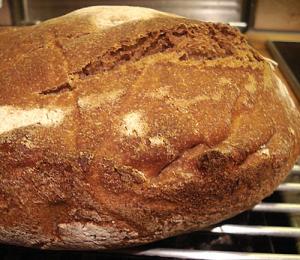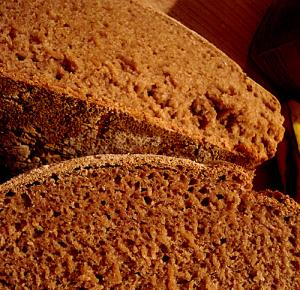 I've adapted the No Knead Bread method for making this bread as described here, for a bread that originally requires at least 20 minutes of kneading. It turns out a quite light, crispy-crust, delicious loaf.
I've adapted the No Knead Bread method for making this bread as described here, for a bread that originally requires at least 20 minutes of kneading. It turns out a quite light, crispy-crust, delicious loaf.
Filed under:
bread baking desem whole wheat
 Like probably everyone, or at least every food blogger, in the world with an oven and a fondness for baking bread, I tried the No Knead Bread as written up in the New York Times in November. Authored by Mark Bittman via Jim Lahey of Sullivan Street Bakery in New York, this almost perplexingly easy method of mixing up a bread dough that has that distinctive 'artisanal bread' crumb and thin, crackly crust caused a sensation in the teapot that is the world of food blogging.
Like probably everyone, or at least every food blogger, in the world with an oven and a fondness for baking bread, I tried the No Knead Bread as written up in the New York Times in November. Authored by Mark Bittman via Jim Lahey of Sullivan Street Bakery in New York, this almost perplexingly easy method of mixing up a bread dough that has that distinctive 'artisanal bread' crumb and thin, crackly crust caused a sensation in the teapot that is the world of food blogging.
As just about everyone says, it does produce a very good bread. And yet...for me it lacked that something extra special. This has a lot to do with the fact that in this country good bread is quite easy to get. Even the bread sold at the major supermarkets is not bad at all. The rather shiny, slightly gummy, open-grained texture of the No Knead Bread reminded me of pain paillase, a very popular twisted loaf bread that's widely sold in Swiss bakeries. The thing is though, pain paillase, being a sourdough bread and baked into a fat baguette shape, is tastier than the all-white flour No Knead Bread. So, I haven't baked any basic No Knead since the first couple of loaves. Besides. I'm trying to cut out white flour at the moment.
Filed under:
bread baking desem whole wheat
This is the final chapter of my accounts of making desem bread, which is made with just flour, water, salt and nothing else. It's somewhere between regular baking and a science project.
My desem is now about three weeks old, and is quite mature. How do I know it's mature? Because, after it's been fed some fresh flour and water, it turns quite spongy within a few hours. It also dissolves completely in water, leaving no strings of gluten in my hand.
Filed under:
bread baking desem
This is the continuation of my accounts of making desem bread, which is made with just flour, water, salt and nothing else. It's somewhere between regular baking and a science project.
Filed under:
bread baking desem
So, once you have a desem, how do you take care of it?
For the second week (that is the week after it's been born, then grown in the in the incubator flour bed), it has to be fed every day. The thing to keep in mind is that you shouldn't feed it more flour than is already in it.
Filed under:
bread baking desem
This is the continuation of my accounts of making desem bread, which is made with just flour, water, salt and nothing else. It's somewhere between regular baking and a science project.
I am writing this somewhat bleary-eyed after a late night...
The process of making the first loaf of desem bread is very long, and it's easy to miscalculate the time needed. That's what I did. Here's how it went...
Filed under:
bread baking desem
This is the continuation of my accounts of making desem bread, which is made with just flour, water, salt and nothing else. It's somewhere between regular baking and a science project.
Filed under:
bread baking desem
Yesterday, I took the cut away desem and made desem dosas. I had never made dosas with desem that was so young before, it but it still came out great.
Filed under:
snack desem favorites
This is the continuation of my accounts of making desem bread, which is made with just flour, water, salt and nothing else. It's somewhere between regular baking and a science project.
The desem has spent its final day covered with flour in the incubator-pot. Today I take it out to start it on its way to being a "mother", for many delicious desem breads to come.
Filed under:
bread baking desem
This is the continuation of my accounts of making desem bread, which is made with just flour, water, salt and nothing else. It's somewhere between regular baking and a science project.
The desem isn't as active today, but it's certainly moving and growing. This is how the incubator-pot looks when I opened it up:
Filed under:
bread baking desem
Pages